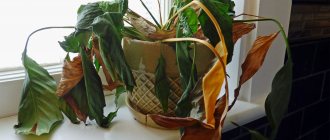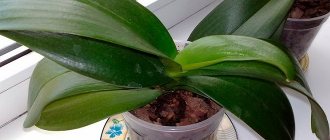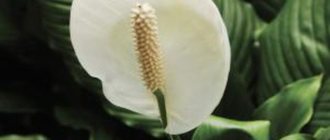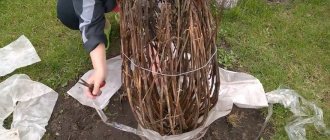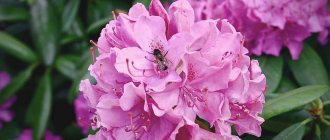Care and maintenance of plants at home
The optimal home conditions under which spathiphyllum grows, develops and blooms normally are:
- Maintaining air humidity . It is necessary not only to water the plant on time, but also to irrigate its foliage. This is especially true on hot days. It is recommended to carry out the procedure several times a day.
- Watering . It is worth being as careful as possible and not allowing the soil to dry out or become waterlogged. It is important to provide a 5 cm thick drainage layer at the bottom of the pot.
- Transplant . As soon as the roots of the plant begin to protrude from the pot, it must be transplanted into a new, more spacious pot as soon as possible.
- Light . Spathiphyllum should be located in a place where there is diffused sunlight. You need to avoid both constantly shady places and direct sunlight.
- Nutrients . The flower needs to be fed in the optimal amount; do not overfeed it, but also do not leave it to “starve”.
We invite you to watch a video on how to properly care for a plant for successful flowering:
What to do and how to make spathiphyllum bloom
You can achieve flowering of spathiphyllum with some effort.
- Here are some recommendations to make the plant bloom:
- Place the pot for 2 weeks in cool conditions with a temperature of +12 ° C, then bring it into a warm place and fertilize it.
- Trim off old parts. This will trigger the release of new inflorescences.
- Reduce the amount of nitrogen fertilizing and increase potassium-phosphorus fertilizing.
- Carry out transplants in accordance with the recommendations, choosing the right soil and pot.
- Renew the plant.
Video: how to make spathiphyllum bloom
Reasons for the lack of flowers in “female happiness”
There are several reasons why spathiphyllum stops blooming. In order to stimulate flowering in a plant, it is worth taking care and creating all the necessary conditions for the formation of flowers. Below we describe in detail why spathiphyllum does not bloom.
Diseases
A common disease that affects spathiphyllum is root rot. The reason for its appearance lies in the excess moisture of the root system. The disease is fungal in nature and develops quickly, damaging the root system, resulting in foliage withering, flowers falling off and roots rotting.
In order to get rid of the disease, you will need to recognize the appearance of root rot in time and use appropriate fungicidal drugs.
We invite you to watch a video about spathiphyllum diseases and measures to prevent them:
Pests
As for the specialized pests of spathiphyllum, they include:
- mealybug;
- aphids;
- spider mite;
- thrips.
If insects appear on the plant and damage becomes noticeable, then you can use folk recipes and get rid of the pests. They have a good effect:
- watering the root with onion broth;
- lemon peel tincture;
- soap solution to irrigate the foliage of the plant.
Use the above remedies only in case of minor damage to the plant.
- If the insects have already managed to live on the spathiphyllum for some time, then they cannot do without chemical insecticides.
- Foliage that harbors pests such as aphids and thrips must be removed from the general flower.
- There are few effective measures in the fight against spider mites, so it is worth taking care of prevention and thoroughly disinfecting the soil in which the flower grows.
- It's also not easy to get rid of scale insects. In most cases, the only solution is to replant the plant.
We invite you to watch a video about spathiphyllum pests:
Soil condition
Soil plays a major role in the normal growth and development of a plant. The absence of buds on spathiphyllum can be caused by the following problems with the soil:
- Insufficient soil aeration . After each watering, the soil in the pot becomes denser and does not allow air to freely penetrate to the roots. To prevent this from happening, it is necessary to constantly loosen the top layer of soil.
- Unsuitable soil , which contains insufficient amounts of micro and macroelements required by the plant. If the soil in which spathiphyllum grows is poor, then the plant will simply have nowhere to get nutrients to enter the flowering phase.
- If there is no drainage layer in the pot , then most likely this will lead to stagnation of water and, as a result, to their rotting.
Wrong care
The plant should be cared for regularly, especially with regard to watering. Despite the fact that such an exotic plant requires watering, excess moisture in the pot should not be allowed, as this will lead to rotting of the roots.
When watering, you need to focus on the condition of the soil and make sure that the soil is not dry, but not wet. Experienced gardeners recommend creating an individual watering schedule for spathiphyllum, which depends on the season, and sticking to it.
Read about how to care for the “female happiness” flower so that it blooms, and how to make it have more buds.
Lack of fertilizer
Plants feel a particularly acute lack of nutrients when quite a long time has passed after transplantation. During the growth and development of the plant, the soil in the pot is depleted and the flower has no place to get nutrients from.
You can compensate for the lack of microelements with the help of fertilizing, which is carried out all year round. In summer, it is necessary to fertilize the soil once a week; in winter, it is enough to fertilize once every 30 days.
You can notice the lack of fertilizers by the appearance of the plant, namely:
- small flowers;
- pale leaf color;
- slow growth.
Incorrect placement location
Spathiphyllum is classified as a shade-tolerant plant, but it is not recommended to keep it constantly in the shade. If it does not have enough sunlight, then it may not bloom. Also, you should not leave the plant in the open sun, especially in summer. Direct sunlight on foliage causes burns.
Wrong pot size
Spathiphyllum does not enter the flowering phase if there are no comfortable growing conditions.
- If the volume of the pot is too small for the root system , then there will be no flowering. You can determine the moment of transplanting spathiphyllum by the protruding roots from the pot. The roots should not occupy more than 70% of the volume, but you should not choose a pot that is too large.
- If there is too much space in the pot , then the root system will not have time to grow and fill the entire volume, which will also affect flowering. It is recommended to select a pot 18 cm in diameter for a medium-sized spathiphyllum.
Other reasons and what to do about them
Lack of air humidity also affects flowering. In its natural habitat, spathiphyllum grows under conditions of high humidity. If there is not enough moisture in the air in the room where the flower stands, this will affect the condition of the plant: the leaves will begin to droop and the flowering will disappear. It is especially worth monitoring this indicator in winter, when the heating is turned on.
It is best to place a container of water next to the plant for the winter or use a spray bottle daily and spray water on the leaves of the flower several times a day.
The optimal temperature conditions during the budding period for spathiphyllum are 18-23 degrees. If the temperature during this period is lower, flowering will not occur.
We invite you to watch a video about the reasons for the lack of flowering of spathiphyllum:
Subtleties of fertilizing
Spathiphyllum does not bloom when the roots do not have enough nutrition. In spring and summer, fertilizing is applied every week. If the weather is cold outside, fertilize the flower once a month. Frequent feeding can destroy the flower.
Experts call mixtures sold in flower shops ideal nutritional supplements. Spathiphyllum will not refuse fertilizer with nitrogen and potassium.
Why does it produce leaves but no buds?
Why does the flower “female happiness” not bloom buds, but only leaves grow? If the appearance of the leaves makes the plant look healthy and strong, but still does not bloom, then the reason for this is mineral supplements. If you apply a large amount of nitrogen fertilizers, you may not wait for flowering. Nitrogen stimulates the growth of green mass to the detriment of flowering . To activate the budding process, you need to fertilize with potassium and phosphorus fertilizers.
Considering all of the above reasons why spathiphyllum does not bloom, it is worth identifying the problem and taking the necessary measures to eliminate it. Proper care, proper feeding, sufficient light and humidity will ensure normal growth and development of the plant, without skipping the flowering phase.
If you find an error, please select a piece of text and press Ctrl+Enter.
Flowering time
With proper care, the plant will bloom for a long time. This usually lasts 10 weeks. Blooming spathiphyllum requires optimal temperature support. The plant blooms in the spring and completes this process in the fall.
The flowers should be snow-white. But due to the bright sun, they may be greener and the leaves paler. With proper care, flowering occurs twice a year. If this happens, the plant needs to be illuminated with a photo lamp. For flowering in summer, it can be placed outside, in a dark place.
The importance of proper feeding
The reason why spathiphyllum does not bloom is sometimes simple starvation - a lack of nutrients. This flower should be given fertilizer all year round. But the frequency of fertilizing should be coordinated with the periods of plant development.
During the warm season, active vegetation occurs, so the soil needs to be fertilized every week. With the onset of cold weather and a period of relative rest, fertilizing is applied only monthly.
Fertilizers containing nitrogen and potassium are very successfully used for spathiphyllum. It is convenient to use complex fertilizers that are sold in stores.
When deciding how to make spathiphyllum bloom at home, young flower growers sometimes go to the other extreme - they overfeed the flower with fertilizers. This harms the plant and can cause root rot.
Maintaining air humidity
The plant comes from a humid climate. And even there he lives near the water. Violation of the humidity regime is often the reason why spathiphyllum does not bloom at home. Therefore, it is very good to spray the plant twice a week. You can wipe the leaves with a damp cloth. Water is used at room temperature. Without spraying, the leaves will lose their usual elasticity.
You can use the following technique to increase air humidity near a flower: put a layer of pebbles in a shallow tray, then pour in water. The pot is placed on pebbles. This way the roots do not get wet from high humidity, and the necessary microclimate is created around the spathiphyllum.


